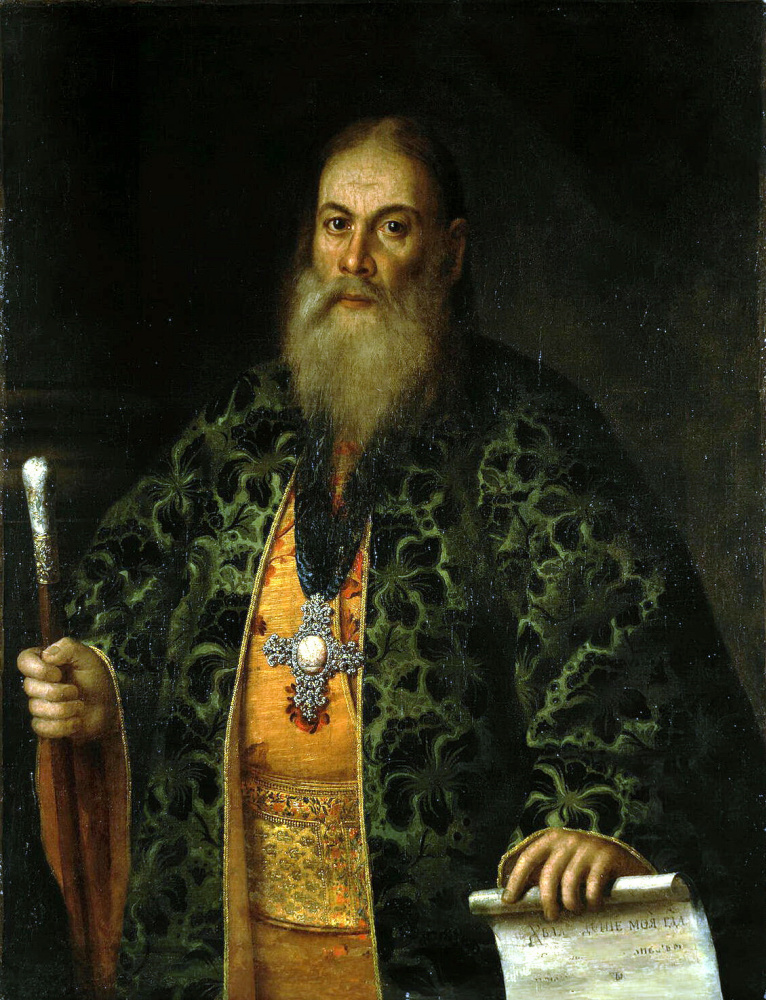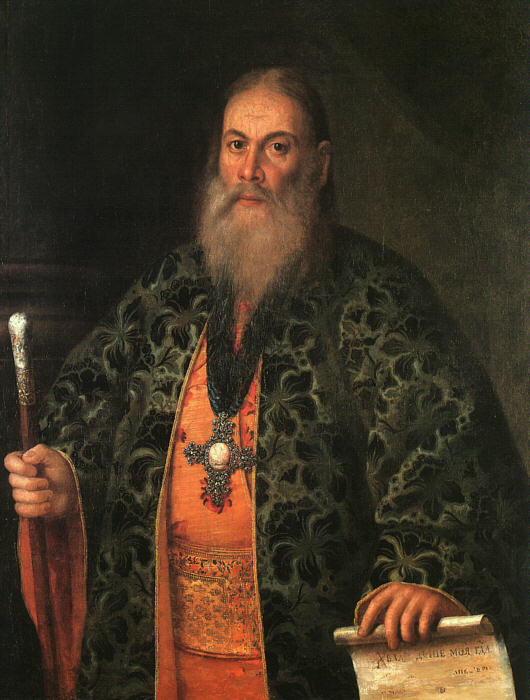log in
Enter site
Login to use Arthive functionality to the maximum
Portrait of Fyodor Dubyansky J. (portrait of a priest with a walking stick and book)
Alexey Antropov • Painting, 1761, 99.5×76.5 cm
Description of the artwork «Portrait of Fyodor Dubyansky J. (portrait of a priest with a walking stick and book)»
"Portrait Of Fyodor Dubyansky Ya." was performed by Alexios antroponym, at least in two copies. One of them came to the Hermitage in 1932 from the hands of the restorer P. A. Sidorova. The other, with small differences (for example, in the first case, the Panagia, the cross, and the second oval), were taken in Rome by the Italian envoy Boris Hosinski. For some time it was believed that the location of the second portrait is unknown: after the exhibition, 1921, he was gone from sight, until it was discovered in the private collection of Galina Vishnevskaya and Mstislav Rostropovich. In 2007, the year at Sotheby's auction their entire collection was bought by Alisher Usmanov and donated to the state. "The second Dubyanskiy" took place in the Konstantinovsky Palace.
Father Fyodor Dubyansky (1691-1772) – notable personality in Russian history. For nearly twenty years he was the spiritual father of the Empress Elizabeth and, as the historian Vasily Klyuchevsky, the daughter of Peter I, in spite of the frivolous temper and a craving for amusements and dancing, Chad was obedient to her Confessor. I assume that it Dubyanskiy has carried out secret wedding of Elizabeth with Alexei Razumovsky.
Father Feodor was distinguished by an impressive external comeliness (which is a portrait of Antropov reports quite), was highly educated, eloquent and, importantly, cool. His calming gravity acted on a few of the hysterical Empress, and the Empress generously of his land and serfs. In early 1760-ies Dubyanskiy even received hereditary nobility, which was able to pass on to their sons – was a guardsman and an active participant in Catherine's coup d'etat Michael and influential Mason Jacob.
Suit Dubyanskiy performed Antropov (pastoral staff with an enamel knob, cross/Panagia, velvet vestment green color with floral ornaments, embroidered with orange sash) is an eclectic mixture of elements from traditional garb of the clergy with the ancient boyar dress. It is assumed that the writing of antropovo portrait is linked to the salary of the father Fyodor nobility.
The change of power in Russia and the reign of Catherine has not weakened the positions of Fyodor Dubyansky at court. Catherine knew how to be grateful: she appreciated the fact that the priest has repeatedly stood up for her before trenirovka "poor cousin" by the Empress Elizabeth. For some time he also was the Confessor of Catherine II. In his right hand the priest holds a scroll on which you can make out the words "Praise the Lord, o my soul..." There are interesting and even ambiguous, given the biography of Dubyanskiy, subtext. These are the words of the 145 Psalm, which continues: "Put not your trust in princes, in sons of men, they also bring salvation..."
Antropov is not quite accurate in the picture. For example, the hands depicted anatomically wrong. Face Dubyanskiy, on the contrary, the artist failed completely: he looks manly, serious and rigid in their religious beliefs. Noteworthy unusual, with a distinct dark greenish, color of the portrait of Fyodor Dubyansky. Alexander Benois believed that addiction Antropov "to black, to yellow, olive tone" due to the fact that Antropov, the official artist of the Synod, inherits the old icon-painting school, and this pseudo-iconic flavor adverse impact on the subsequent history of Russian painting.
Author: Anna Yesterday
Father Fyodor Dubyansky (1691-1772) – notable personality in Russian history. For nearly twenty years he was the spiritual father of the Empress Elizabeth and, as the historian Vasily Klyuchevsky, the daughter of Peter I, in spite of the frivolous temper and a craving for amusements and dancing, Chad was obedient to her Confessor. I assume that it Dubyanskiy has carried out secret wedding of Elizabeth with Alexei Razumovsky.
Father Feodor was distinguished by an impressive external comeliness (which is a portrait of Antropov reports quite), was highly educated, eloquent and, importantly, cool. His calming gravity acted on a few of the hysterical Empress, and the Empress generously of his land and serfs. In early 1760-ies Dubyanskiy even received hereditary nobility, which was able to pass on to their sons – was a guardsman and an active participant in Catherine's coup d'etat Michael and influential Mason Jacob.
Suit Dubyanskiy performed Antropov (pastoral staff with an enamel knob, cross/Panagia, velvet vestment green color with floral ornaments, embroidered with orange sash) is an eclectic mixture of elements from traditional garb of the clergy with the ancient boyar dress. It is assumed that the writing of antropovo portrait is linked to the salary of the father Fyodor nobility.
The change of power in Russia and the reign of Catherine has not weakened the positions of Fyodor Dubyansky at court. Catherine knew how to be grateful: she appreciated the fact that the priest has repeatedly stood up for her before trenirovka "poor cousin" by the Empress Elizabeth. For some time he also was the Confessor of Catherine II. In his right hand the priest holds a scroll on which you can make out the words "Praise the Lord, o my soul..." There are interesting and even ambiguous, given the biography of Dubyanskiy, subtext. These are the words of the 145 Psalm, which continues: "Put not your trust in princes, in sons of men, they also bring salvation..."
Antropov is not quite accurate in the picture. For example, the hands depicted anatomically wrong. Face Dubyanskiy, on the contrary, the artist failed completely: he looks manly, serious and rigid in their religious beliefs. Noteworthy unusual, with a distinct dark greenish, color of the portrait of Fyodor Dubyansky. Alexander Benois believed that addiction Antropov "to black, to yellow, olive tone" due to the fact that Antropov, the official artist of the Synod, inherits the old icon-painting school, and this pseudo-iconic flavor adverse impact on the subsequent history of Russian painting.
Author: Anna Yesterday



